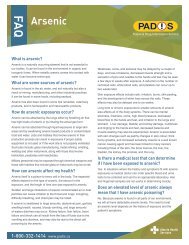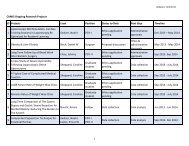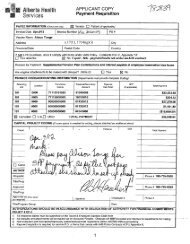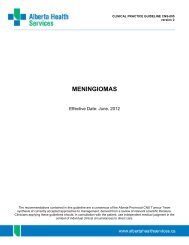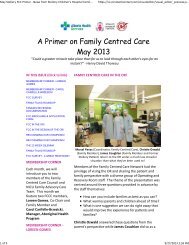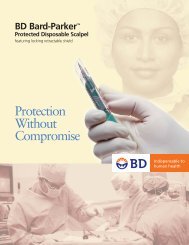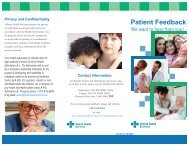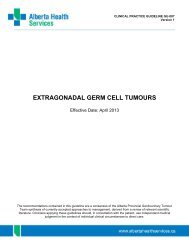Chronic Lymphocytic Leukemia - Alberta Health Services
Chronic Lymphocytic Leukemia - Alberta Health Services
Chronic Lymphocytic Leukemia - Alberta Health Services
Create successful ePaper yourself
Turn your PDF publications into a flip-book with our unique Google optimized e-Paper software.
CLINICAL PRACTICE GUIDELINE LYHE-007<br />
Version 2<br />
CHRONIC LYMPHOCYTIC LEUKEMIA<br />
Effective Date: March, 2013<br />
The recommendations contained in this guideline are a consensus of the <strong>Alberta</strong> Provincial Hematology Tumour<br />
Team synthesis of currently accepted approaches to management, derived from a review of relevant scientific<br />
literature. Clinicians applying these guidelines should, in consultation with the patient, use independent medical<br />
judgment in the context of individual clinical circumstances to direct care.
BACKGROUND<br />
CLINICAL PRACTICE GUIDELINE LYHE-007<br />
Version 2<br />
<strong>Chronic</strong> lymphocytic leukemia (CLL) is characterized by the progressive accumulation of functionally<br />
incompetent monoclonal lymphocytes. CLL is the most common adult leukemia in the Western world,<br />
accounting for approximately seven percent of non-Hodgkin lymphomas. (1) In Canada, the median age at<br />
diagnosis is approximately 72 years, with ten percent of cases diagnosed in patients younger than 50<br />
years of age. Age-adjusted incidence rates are 7.5 per 100,000 person-years, with males representing<br />
approximately 56 percent of the cases. The five-year survival is approximately 80 percent in men and 85<br />
percent in women. (2) In determining the optimal treatment for CLL, individual patient characteristics<br />
including performance status and disease stage must be considered.<br />
GUIDELINE QUESTIONS<br />
• What are the recommended diagnostic and staging criteria for adult patients in <strong>Alberta</strong> with CLL?<br />
• What are the recommended treatment strategies for adult patients in <strong>Alberta</strong> with newly diagnosed,<br />
relapsed, or refractory CLL?<br />
• What are the recommended follow-up and supportive care practices for adult patients in <strong>Alberta</strong> with<br />
CLL?<br />
DEVELOPMENT AND REVISION HISTORY<br />
Portions of this guideline document were adapted, with permission, from recommendations developed by<br />
a steering committee consisting of hematologists from across Canada. This guideline was reviewed and<br />
endorsed by the <strong>Alberta</strong> Provincial Hematology Tumour Team. Members of the <strong>Alberta</strong> Provincial<br />
Hematology Tumour Team include medical oncologists, radiation oncologists, surgical oncologists,<br />
nurses, pathologists, and pharmacists. Evidence was selected and reviewed by a working group<br />
comprised of members from the <strong>Alberta</strong> Provincial Hematology Tumour Team and a Knowledge<br />
Management Specialist from the Guideline Utilization Resource Unit. A detailed description of the<br />
methodology followed during the guideline development process can be found in the Guideline Utilization<br />
Resource Unit Handbook.<br />
This guideline was originally developed in (May, 2010). This guideline was revised in March 2013.<br />
SEARCH STRATEGY<br />
An updated review of the literature was conducted by searching journal articles using the Medline (1950 to<br />
April Week 1, 2010), EMBASE (1980 to April Week 1, 2010), Cochrane Database of Systematic Reviews<br />
(1 st Quarter, 2010), and PubMed electronic databases. The MeSH heading “<strong>Leukemia</strong>, <strong>Lymphocytic</strong>,<br />
<strong>Chronic</strong>, B-Cell” was combined with the search terms “drug therapy” and “therapy”. The results were<br />
limited to adults, practice guidelines, systematic reviews, meta-analyses, multicentre studies, randomized<br />
controlled trials, and clinical trials. Articles were excluded from the final review if they: had a non-English<br />
abstract, were not available through the library system, or were published before the year 2000. The<br />
references and bibliographies of articles identified through these searches were scanned for additional<br />
sources. A search for practice guidelines published since January 2000 was conducted by accessing the<br />
websites of the following organizations: Cancer Care Ontario, British Columbia Cancer Agency, the<br />
National Comprehensive Cancer Network, the European Society for Medical Oncology, and the Italian<br />
Society of Hematology/Italian Group for Bone Marrow Transplantation.<br />
Page 2 of 23
TARGET POPULATION<br />
CLINICAL PRACTICE GUIDELINE LYHE-007<br />
Version 2<br />
The following guidelines apply to adults over 18 years of age. Different principles apply to pediatric<br />
patients.<br />
RECOMMENDATIONS<br />
Diagnosis and Prognosis:<br />
1. The initial diagnosis of CLL relies on the detection of a circulating B-lymphocyte count greater than or<br />
equal to 5 x 10 9 /L in the peripheral blood, for the duration of at least 3 months associated with a<br />
characteristic flow cytometry immunophenotype profile including CD19/CD5/CD23/CD43 positivity and<br />
cyclin D1 negativity. Small lymphocytic lymphoma is diagnosed when a lymph node or other tissue<br />
biopsy demonstrates a malignant lymphocytic infiltration with cells showing the same<br />
immunophenotype as CLL, but associated with a circulating B-lymphocyte count that does not exceed<br />
5 x 10 9 /L.<br />
2. Flow cytometry for ZAP-70 and CD38 expression may be performed at diagnosis to help with<br />
prognosis, and guide the frequency of follow-up visits and predict time to initial therapy.<br />
3. FISH cytogenetic analysis for del(17p) or del(11q) should be performed at the time when patients are<br />
started on first line treatment. FISH analysis for del(17p) should be repeated at the time of second or<br />
third line therapy if patients are potential candidates for allogeneic stem cell transplantation or<br />
alemtuzumab.<br />
First-Line Treatment Options:<br />
4. The majority of patients with early-stage CLL are managed initially with watchful waiting. The decision<br />
to initiate treatment should be based upon symptoms, advanced disease (bulky adenopathy/<br />
splenomegaly or cytopenias), or evidence for rapid disease progression (e.g. lymphocyte count<br />
doubling within 6 months).<br />
5. Patient fitness and co-morbidities should be considered to determine whether aggressive treatments<br />
can be tolerated. In physically fit CLL patients who are able to tolerate more aggressive treatment, the<br />
combination of fludarabine + cyclophosphamide + rituximab (FCR) is recommended. The potential for<br />
toxicity of this regimen suggests that patients who have some comorbidities may benefit from less<br />
aggressive treatments such as rituximab + fludarabine (FR) or chlorambucil + rituximab (CLB-R).<br />
6. In frail patients with significant co-morbidities and competing causes of death, less toxic treatment<br />
options are warranted. In such cases, or if a patient declines intravenous treatment, oral chlorambucil<br />
is recommended as first choice, followed by oral fludarabine monotherapy as an alternative treatment.<br />
7. Patients whose CLL possesses del(17p) usually do not respond to standard chemotherapy options for<br />
CLL. In such cases, alemtuzumab or early use of allogeneic stem cell transplantation could be<br />
considered as reasonable options.<br />
Page 3 of 23
Second-Line Treatment Options:<br />
CLINICAL PRACTICE GUIDELINE LYHE-007<br />
Version 2<br />
8. In fit patients, FCR is an effective regimen for rituximab naïve patients or FC. Re-treatment with FCR<br />
is a reasonable treatment option for patients experiencing a long remission (more than two years)<br />
after initial FCR treatment.<br />
9. The combination of fludarabine and low-dose alemtuzumab (FluCam) is a safe and effective therapy<br />
for relapsed/refractory CLL and has been demonstrated to improve PFS and OS compared to<br />
monotherapy with fludarabine.<br />
10. In frail patients, fludarabine or chlorambucil are reasonable second-line treatment options. If the initial<br />
remission is greater than 1 year, re-treatment with the initial chemotherapy agent is recommended. If<br />
the initial remission is shorter than 1 year, treatment with a different second-line agent is indicated.<br />
11. Allogeneic stem cell transplantation may also be considered for fit patients who are younger than 65<br />
years of age and who have not responded to therapy, have progressive disease within 1 year of<br />
fludarabine treatment or within 2 years of fludarabine-based combination treatment, or those whose<br />
CLL possesses del(17p) and require treatment.<br />
12. Chemo-sensitivity should be demonstrated prior to stem cell transplantation. Several small studies<br />
have reported encouraging response rates after treatment with high dose corticosteroids in patients<br />
with refractory CLL or in patients with del(17p).<br />
Follow-up and Supportive Care:<br />
13. Patients with CLL often have compromised immune systems due to either the disease itself and/or the<br />
associated treatments. Antibiotic prophylaxis and regular vaccinations are recommended, depending<br />
on the type of treatments administered. PCP and anti-viral prophylaxis are strongly recommended for<br />
all patients receiving FCR or FluCam. Patients treated with alemtuzumab should also be screened for<br />
CMV reactivation with weekly CMV PCR.<br />
14. Special attention should be paid to the appearance of autoimmune cytopenias, such as autoimmune<br />
hemolytic anemia, immune thrombocytopenia purpura, and pure red-cell aplasia, which occur in up to<br />
11 percent of patients with CLL.<br />
DISCUSSION<br />
I. Diagnosis<br />
CLL is described by the World <strong>Health</strong> Organization (WHO) as a neoplasm composed of monomorphic<br />
small, round-to-slightly irregular B-lymphocytes in the peripheral blood, bone marrow, spleen, and lymph<br />
nodes, admixed with prolymphocytes and paraimmunoblasts forming proliferation centres in tissue<br />
infiltrates. (1) According to the 2008 International Workshop on CLL (IWCLL) guidelines, the diagnosis of<br />
CLL requires a circulating B-lymphocyte count greater than or equal to 5 x 10 9 /L in the peripheral blood,<br />
for the duration of at least 3 months. (3) Although CLL and small lymphocytic lymphoma (SLL) are<br />
categorized by the WHO as similar entities, the term SLL is used to indicate neoplastic tissue infiltration in<br />
lymph nodes, spleen, or other organs associated with a circulating B-lymphocyte count that does not<br />
exceed 5 x 10 9 /L. (1)<br />
Page 4 of 23
CLINICAL PRACTICE GUIDELINE LYHE-007<br />
Version 2<br />
Monoclonal B-cell lymphocytosis (MBL) is a condition that resembles CLL, but does not require treatment.<br />
As many as 12 percent of healthy individuals over the age of 40 may have low levels (less than 5 x 10 9 /L)<br />
of circulating monoclonal B-cells that are phenotypically identical to CLL cells, but with no evidence of<br />
tissue infiltration. (4) MBL progresses to CLL at a rate of one to two percent of patients per year. (3,5)<br />
Clinical features of CLL vary in their presentation, course, and outcome. Patients are often asymptomatic<br />
at diagnosis, but fatigue, autoimmune hemolytic anemia, infections, splenomegaly, hepatomegaly,<br />
lymphadenopathy, or extra-nodal infiltrates may be present. Some patients may also exhibit a small serum<br />
monoclonal protein, an M-component. Although in rare cases patients may not have lymphocytosis at<br />
diagnosis, peripheral blood and bone marrow are usually involved as the disease progresses. Lymph<br />
nodes, liver, and spleen are commonly infiltrated, with other extra-nodal sites becoming involved in some<br />
patients. (1)<br />
Although some CLL cases may have an atypical immunophenotype, the characteristic profile includes<br />
CD19/CD5/CD23/CD43 positivity with weak CD20 and CD11c positivity and dim surface immunoglobulin<br />
expression with restricted light chain expression. (1)<br />
II. Staging<br />
Two widely accepted staging methods, the modified Rai and the Binet systems, are used in both patient<br />
care and for clinical trials; the modified Rai system is the most commonly used in Canada. These staging<br />
systems are relatively simple, relying solely on physical examination and standard laboratory tests. (6-8)<br />
Table 1. Rai and Modified Rai Classification System for CLL<br />
Stage<br />
Description Risk Status Median Survival<br />
(Rai)<br />
(Modified Rai) (years)<br />
0 Lymphocytosis, with lymphoid cells >30% in the blood and/or bone marrow Low 11.7<br />
I Stage 0 with enlarged node(s) Intermediate 8.3<br />
II Stage 0–1 with splenomegaly, hepatomegaly, or both Intermediate 5.8<br />
III Stage 0–II with hemoglobin
• del(17p) in 3 to 27% of patients (3)<br />
CLINICAL PRACTICE GUIDELINE LYHE-007<br />
Version 2<br />
In general, patients with a normal karyotype or isolated del(13q) can be categorized as low risk with<br />
prolonged time to disease progression and better chances of long-term survival, whereas patients with<br />
del(17p), and del(11q) are more likely to have a poor prognosis. (9) Patients with trisomy 12 have a<br />
treatment advantage over those with del(17p) or del(11q), as they tend to respond better to fludarabinebased<br />
therapy. In addition, patients with del(11q) appear to benefit from the addition of cyclophosphamide<br />
to fludarabine (FC), and do particularly well with FC plus rituximab (FCR). (10) Del(17p) leads to loss of the<br />
p53 tumour suppressor gene, which mediates cell death induced by alkylating agents and purine<br />
analogues. Hence, patients with del(17p) are typically less responsive to these agents, but may respond<br />
to agents such as alemtuzumab, flavopiridol, lenalidomide or high dose steroids. (3) FISH analysis may<br />
therefore be useful in the selection of patients with high risk disease who might benefit from allogeneic<br />
stem cell transplantation. Such patients are at high risk of treatment failure and are likely to become<br />
refractory to treatment or to relapse early after fludarabine-based therapy. (11)<br />
IgVH mutational status and VH3.21 gene usage. Approximately half of all CLL patients have leukemic<br />
cells with somatic hyper-mutations in the immunoglobulin heavy chain variable region (IgVH) genes.<br />
Patients with mutated CLL have improved survival as compared to those with unmutated CLL. (3,9) Patients<br />
with unmutated CLL exhibit faster disease progression, atypical peripheral blood cell morphology, adverse<br />
cytogenetic features, and clonal evolution. (9) The VH3.21 gene is an unfavourable prognostic marker,<br />
regardless of IgVH mutational status. (3) Sequencing of the genome required to determine IgVH mutational<br />
status is expensive, time-consuming, and not readily available for clinical purposes at most sites. There is<br />
also currently no evidence that unmutated IgVH should influence treatment decision-making.<br />
ZAP-70 and CD38 expression. In the course of identifying surrogate markers for IgVH mutational status,<br />
a small number of genes were identified that allow the separation of mutated and unmutated CLL. The<br />
most specific of these genes is the one that encodes for a 70-kD zeta-associated protein (ZAP-70). The<br />
majority of mutated CLL cases are ZAP-70 negative (defined as ≤20% positive cells), whereas unmutated<br />
forms are more often ZAP-70 positive (defined as >20% positive cells). (9) Discordance of ZAP-70<br />
expression and IgVH mutational status is reported in about 25 percent of CLL patients. (12) Positive ZAP-70<br />
predicts more rapid disease progression and poorer survival. At present, ZAP-70 analysis is hampered by<br />
variation in technique, leading to inconsistent results across centres and not routinely recommended in<br />
most centres.<br />
CD38 is an ectoenzyme involved in transmembrane signaling and cell adhesion, and can correlate with<br />
unmutated IgVH status, predicting a poor prognosis. Though easy to perform through flow cytometric<br />
techniques, CD38 is discordant with IgVH mutational status in a significant proportion of cases and<br />
variability in results over time are drawbacks for its use. (3)<br />
Serum markers. Serum markers such as CD23, thymidine kinase (TK), and ß2-microglobulin (ß2M) may<br />
predict overall- or progression-free survival (PFS). (3) Even in cases of early stage disease, serum TK<br />
levels correlate with tumour mass and proliferative activity of CLL cells. In addition, high levels of CD23<br />
are associated with diffuse bone marrow infiltration and rapid lymphocyte doubling time. Serum TK and<br />
CD23 assays are not routinely used in Canada. Alternatively, serum levels of β2M are easily available at<br />
most Canadian centres and correlate with both clinical stage and overall survival. (9)<br />
The value of prognostic markers in elderly patients is questionable with evidence suggesting that most of<br />
the reported prognostic factors are not relevant to the elderly CLL population. (13)<br />
Page 6 of 23
IV. Patient Fitness and Response Assessments<br />
CLINICAL PRACTICE GUIDELINE LYHE-007<br />
Version 2<br />
Assessing patient fitness. Patient fitness and co-morbidities should be considered in treatment<br />
decisions to determine whether aggressive treatments can be tolerated. Several scales exist for<br />
determining patient fitness, two of the most common being the Eastern Cooperative Oncology Group<br />
(ECOG) Performance Status and the Cumulative Illness Rating Scale (CIRS), both of which can be found<br />
in Appendix A. (14,15) The CIRS assesses co-morbidities in different organ systems by assigning points to<br />
various conditions such as heart disease. The physician tabulates the number of points in a variety of<br />
body systems, with a low score indicating optimal health. (16) The CIRS has been used in combination with<br />
creatinine clearance (CrCl) by the German CLL Study Group to assess patient fitness for eligibility in a<br />
phase III study. (16)<br />
Once a fitness score has been determined, it is possible to group patients into a fit or frail group:<br />
• Fit Group<br />
o ECOG Performance Status 0-2, or<br />
o CIRS ≤6 and CrCl ≥70 mL/min<br />
• Frail Group<br />
o ECOG Performance Status 3–4, or<br />
o CIRS >6 or CrCl
CLINICAL PRACTICE GUIDELINE LYHE-007<br />
Version 2<br />
six months of treatment are identified as having refractory disease. Those demonstrating PD more than<br />
six months after treatment has ended, who have previously achieved a CR or PR, are identified as having<br />
relapsed disease. (3)<br />
Table 3. Criteria for Identifying Treatment Response (3)<br />
Parameter Complete response Partial response Progressive disease<br />
(CR)<br />
(PR)<br />
(PD)<br />
Lymphadenopathy None >1.5 cm Decrease ≥50% Increase ≥50% or<br />
appearance of any new<br />
lesion<br />
Liver and/or spleen<br />
size<br />
Constitutional<br />
symptoms<br />
Polymorphonuclear<br />
leukocytes<br />
Normal size Decrease ≥50% Increase ≥50% or new<br />
enlargement when<br />
previously normal<br />
None Any Any Any<br />
>1.5 x 10 9 /L without<br />
need for exogenous<br />
growth factors<br />
>1.5 x 10 9 /L or >50%<br />
improvement over<br />
baseline without need for<br />
exogenous growth factors<br />
Circulating clonal B- None Decrease ≥50% over<br />
lymphocytes<br />
baseline<br />
Platelet count >100 x 10 9 /L without >100 x 10<br />
need for exogenous<br />
growth factors<br />
9 /L or increase<br />
≥50% over baseline<br />
Hemoglobin >110 g/L (untransfused >110 g/L or increase<br />
and without need for<br />
exogenous<br />
erythropoietin)<br />
≥50% over baseline<br />
Marrow Normocellular for age, No BM requirements to<br />
CLINICAL PRACTICE GUIDELINE LYHE-007<br />
Version 2<br />
convenient oral dosing and well-established side effect profile make chlorambucil a valuable option for<br />
frail patients or for those who decline or are unsuitable for more intensive intravenous therapy. (21-24)<br />
Fludarabine<br />
Fludarabine has been shown to produce response rates of between 50 and 60 percent in patients<br />
refractory to traditional alkylating-agent therapy. (25, 26) The superior activity of fludarabine has also been<br />
confirmed in treatment-naïve patients. In randomized comparisons to alkylating agents, fludarabine has<br />
demonstrated a superior clinical response, with response rates of 60 to 80 percent and CR rates of 15 to<br />
20 percent. (21,23,27,28) A Cochrane meta analysis of four randomized trials confirmed the findings of superior<br />
PFS with fludarabine (HR=0.70; p
CLINICAL PRACTICE GUIDELINE LYHE-007<br />
Version 2<br />
alone. Based on the results of phase II trials, some Canadian centres have adopted the use of FR as the<br />
standard first-line treatment in both fit and frail patients. Further studies evaluating the FR regimen are<br />
currently underway, which may help to clarify its role in CLL patient subsets.<br />
Fludarabine-cyclophosphamide-rituximab (FCR). The best evidence to date for the treatment of fit<br />
CLL patients comes from a phase III study by the German CLL Study Group (CLL-8 study) comparing the<br />
primary endpoint of PFS after treatment with FCR or FC. (16) Study participants included 817 patients<br />
selected for minimal co-morbidity (CIRS
CLINICAL PRACTICE GUIDELINE LYHE-007<br />
Version 2<br />
reported a 31 percent response in patients with this high-risk profile. (43) In the first-line setting, results of a<br />
randomized controlled trial comparing alemtuzumab to chlorambucil were reported by Hillmen et al. (22) Of<br />
the 282 patients who underwent FISH cytogenetic analysis, 20 (7%) patients had del(17p). Patients with<br />
del(17p) who were treated with alemtuzumab had a PFS of 10.7 months compared to 2.2 months for<br />
patients who received chlorambucil. Although there was a trend of increased PFS in the del(17p) group<br />
treated with alemtuzumab, it did not reach statistical significance. Overall response rates for these two<br />
groups were 64 and 20 percent, respectively. Given the limited effectiveness of standard therapy in<br />
patients with del(17p), alemtuzumab may be considered a valuable alternative in this poor-risk group. A<br />
single arm, open-label study of patients with CLL with del(17p) also examined alemtuzumab in<br />
combination with high dose steroids. The alemtuzumab was provided at 30mg 3x/week for 16 weeks in<br />
combination with high dose methylprednisolone 1.0g/m2/day for 5 days on a 28 day cycle for 4 cycles.<br />
Eighty-two percent of patients had an objective response with 36% achieving a CR. The median PFS and<br />
OS of previously untreated patients were 18.3 months and 38.9 months, respectively, improved compared<br />
to all historical controls for this patient population. (46)<br />
Second-Line Treatment Options for Relapsed and Refractory Patients with CLL<br />
Recommendations for second-line treatment of CLL should consider individual factors such as<br />
comorbidities and the length of the disease-free interval. Patients experiencing treatment failure within six<br />
months of treatment are identified as having refractory disease. Those demonstrating progressive disease<br />
after more than six months of treatment, who have previously achieved a CR or PR, are identified as<br />
having relapsed disease. When initial remission is greater than one year, re-treatment with the initial<br />
regimen is reasonable; in shorter remissions, treatment with a different second-line regimen is indicated.<br />
In frail patients, fludarabine and chlorambucil are reasonable second-line options where they have not<br />
been given previously, or in those experiencing a long remission from either regimen. (23-26) In fit patients,<br />
FCR is an effective regimen in patients naïve to rituximab or FC; reuse of FCR is also reasonable in<br />
patients experiencing a long remission (more than two years) after initial treatment. (47)<br />
Fludarabine and alemtuzumab combination therapy (FluCam)<br />
The combination of fludarabine and alemtuzumab (FluCam) was compared in a Phase III study to<br />
fludarabine monotherapy in 335 patients with relapsed/refractory CLL after 1 prior line of therapy. Patients<br />
in the combination group received fludarabine 30mg/m2 per day and alemtuzumab 30mg per day on days<br />
1-3 of a 28 day cycle while patients in the monotherapy arm received fludarabine 25mg/m2 on days 1-5.<br />
Patients receiving FluCam had a significantly improved PFS (23.7 months compared to 16.5months<br />
[p=0.003]) and had a significantly improved OS (median not reach compared to 52.9 months [p=0.021]).<br />
Adverse events were similar in the 2 groups with the exception of cytomegalovirus events (14% in the<br />
FluCam group compared to
CLINICAL PRACTICE GUIDELINE LYHE-007<br />
Version 2<br />
Allogeneic stem cell transplantation. Allogeneic stem cell transplantation may be considered for fit<br />
patients younger than 65 years who:<br />
• Have no response to initial CLL therapy<br />
• Have progressive disease within one year of fludarabine treatment or within two years of fludarabinebased<br />
combination therapy, or<br />
• Have CLL with del(17p) abnormalities and require treatment (11)<br />
VI. Managing Complications and Supportive Care in CLL<br />
Prevention and management of infections. Patients with CLL often have compromised immune<br />
systems due to the disease itself and/or its associated treatments. Infections are therefore common, and<br />
prophylaxis is appropriate, depending on the type of treatment given. The use of live vaccines in patients<br />
with CLL is not recommended. However, the use of inactivated vaccines such as annual influenza and<br />
pneumococcal polysaccharide (PPV) every five years for patients in remission for more than three months<br />
is recommended. (54,55) Table 4 summarizes antibiotic prophylaxis and recommended vaccinations for<br />
patients with CLL.<br />
Table 4. Antibiotic Prophylaxis and Vaccinations in Patients with CLL<br />
Treatment Possible<br />
infection<br />
Splenectomy Encapsulated<br />
bacteria<br />
Alemtuzumab or<br />
allogeneic stem<br />
cell transplant<br />
Alemtuzumab,<br />
fludarabine,<br />
or rituximab<br />
Alemtuzumab<br />
Fludarabinebased<br />
treatment<br />
Antibiotic prophylaxis Vaccine Other<br />
Penicillin Pneumococcal,<br />
Hemophilus, and<br />
Meningococcal prior to<br />
CMV Valgancyclovir pre-emptive therapy<br />
for increased PCR<br />
Hepatitis B Lamivudine 100 mg/day orally for<br />
the entire duration of chemotherapy<br />
and 6 months afterwards<br />
Varicella Zoster Acyclovir or equivalent n/a<br />
Pneumocystis<br />
jirovecii<br />
pneumonia or<br />
Varicella Zoster<br />
Bactrim or equivalent and acyclovir<br />
or equivalent should be considered<br />
splenectomy<br />
n/a CMV monitoring by<br />
PCR every 1–2 weeks<br />
n/a Avoid in patients with<br />
known prior hepatitis B<br />
When infections occur, they should be diagnosed, treated, and reported. The etiology of any infection<br />
should be identified as bacterial, viral, or fungal, and the severity should be quantified as:<br />
• Minor: requiring either oral antimicrobial therapy or symptomatic care alone<br />
• Major: requiring hospitalization and systemic antimicrobial therapy<br />
• Fatal: death as a result of the infection (3)<br />
Where patients experience recurrent infections that require intravenous antibiotics or hospitalization,<br />
antimicrobials should be given as needed. In patients with recurrent infections and where serum IgG is<br />
less than 5 g/L, monthly intravenous immunoglobulins should be given at 0.3–0.5 g/kg; dose and interval<br />
should be adjusted to maintain a nadir level of more than 5 to 7 g/L. (26)<br />
Auto-immune cytopenias. Patients with CLL are at increased risk of developing auto-immune<br />
cytopenias, such as autoimmune hemolytic anemia (AIHA), idiopathic thrombocytopenia purpura (ITP),<br />
and pure red cell aplasia (PRCA). AIHA will develop in approximately 11 percent of advanced-stage CLL<br />
n/a<br />
Page 12 of 23
CLINICAL PRACTICE GUIDELINE LYHE-007<br />
Version 2<br />
patients. (56) AIHA is diagnosed by the presence of at least one marker of hemolysis (increased indirect<br />
bilirubin not due to liver disease, increased lactate dehydrogenase without alternative etiology, increased<br />
absolute reticulocyte count, increased bone marrow erythropoiesis in the absence of bleeding, or<br />
decreased haptoglobin) with direct or indirect evidence of an autoimmune mechanism (positive direct<br />
antiglobulin test (DAT) for either IgG or C3d, cold agglutinins, or at least two markers of hemolysis in the<br />
absence of evidence of bleeding or hypersplenism). (57)<br />
ITP is less common, occurring in two to three percent of CLL patients at diagnosis or during early stage<br />
disease. (56) ITP can be identified where platelet counts are less than or equal to 100 × 10 9 /L with no<br />
evidence of hypersplenism, no evidence of increased platelet consumption due to other causes, and<br />
normal or increased megakaryocytes on bone marrow examination. (58) PRCA is present in six percent of<br />
CLL patients that are tested. (56) PRCA can be diagnosed when hemoglobin concentration is less than or<br />
equal to 120 g/L, with reticulocytopenia and isolated absence of erythrocyte precursors in the bone<br />
marrow. Parvovirus infection must be ruled out, which can be done by using a blood polymerase chain<br />
reaction (PCR) assay. (59)<br />
ITP and AIHA, as a single abnormality caused by CLL, should be treated initially using glucocorticoids.<br />
Several case reports and small series have described an increased risk of AIHA following single-agent<br />
fludarabine therapy, particularly in patients with a positive DAT. Combination therapy or chlorambucil<br />
monotherapy may be preferable in the treatment of patients with CLL with a history of AIHA. Second-line<br />
options for AIHA include splenectomy and intravenous immunoglobulins. Good responses have also been<br />
obtained using rituximab or alemtuzumab. (3) Refractory cases could be considered for immune<br />
suppressive therapy with cyclosporine A, azathioprine, or low-dose cyclophosphamide, although these<br />
agents are associated with high rates of infection and other complications. Most patients with PRCA will<br />
respond to therapy with cyclosporine A or corticosteroids, but prolonged high doses are usually needed;<br />
steroid-sparing agents such as cyclophosphamide may therefore be required. (57,58) Rituximab may be an<br />
additional option for the treatment of PRCA, but success rates are lower than those seen for AIHA or<br />
ITP. (57)<br />
Richter syndrome. The majority of Richter syndrome cases involve the transformation of CLL to diffuse<br />
large B-cell lymphoma (DLBCL). The morphology of DLBCL consists of sheets of large neoplastic Blymphocytes<br />
clearly distinguishable from small lymphocytes, with sparse cytoplasm and clumped<br />
chromatin typical of CLL. Diagnosis of Richter syndrome requires the pathologic identification of CLL<br />
transformation to aggressive lymphoma. Ideally, this should be determined by histology using a biopsy of<br />
the index lesion. (59) Based on existing data, Richter syndrome may be treated with cytoreductive<br />
chemotherapy appropriate for DLBCL (e.g. R-CHOP), with the goal of achieving a response. The role of<br />
consolidation therapies previously tested for CLL or DLBCL in patients responding to initial therapy as well<br />
as the impact of new first-line therapies, may aid in the development of an ideal treatment approach in<br />
these patients. (59) Allogeneic stem cell transplantation should also be considered in younger fit patients<br />
with Richter syndrome who respond to initial therapy. (60)<br />
Tumour lysis syndrome. Tumour lysis syndrome occurs when the release of large amounts of<br />
intracellular components of lysed malignant cells leads to a number of metabolic imbalances. Resulting<br />
hyperuricemia, hyperkalemia, and hyperphosphatemia may then lead to renal failure and cardiac<br />
arrhythmias. Tumour lysis syndrome usually occurs within two or three days after the initiation of therapy,<br />
with rare cases occurring after second-line treatment. Major risk factors include high tumour burden, high<br />
rate of proliferation, and disease that is highly responsive to therapy. (61)<br />
Page 13 of 23
CLINICAL PRACTICE GUIDELINE LYHE-007<br />
Version 2<br />
Before the initiation of treatment, patients with a white blood cell (WBC) count higher than 50,000/mm 3<br />
should be adequately hydrated and monitored frequently. In patients with previous episodes of tumour<br />
lysis syndrome, consultation with a nephrologist should be considered. Where overt uremic symptoms are<br />
present, dialysis may be necessary in order to prevent acute renal failure. In outpatients, frequent<br />
monitoring of serum electrolytes and uric acid is recommended as a preventative measure. (61)<br />
Prophylactic allopurinol (300 mg/day orally) is necessary when a rapid lysis of large numbers of<br />
lymphocytes is anticipated (initial WBC count >200 x 10 9 /L). Allopurinol should also be given to patients<br />
with significant renal dysfunction or chronic hyperuricemia. In the advent of tumour lysis syndrome it may<br />
be necessary to interrupt treatment until symptoms are resolved. Cardiac activity should be monitored<br />
continuously, and frequent monitoring of electrolyte levels is recommended. (61) Rasburicase may also be<br />
considered for the prevention and treatment of tumour lysis syndrome in patients with a high WBC count,<br />
coexistent renal insufficiency, and an allopurinol intolerance or allergy.<br />
Close monitoring for tumour lysis syndrome is recommended for patients with lymphocytosis greater than<br />
30 x 10 9 /L who are receiving a first cycle of rituximab. Consideration may be given to dividing the dose<br />
over two days for the first infusion.<br />
Blood product support. Transfusion-related graft-versus-host disease has been described in patients<br />
actively receiving fludarabine or alemtuzumab. Canadian Blood <strong>Services</strong> recommends that patients on<br />
fludarabine or alemtuzumab should receive irradiated and cytomegalovirus-negative blood products.<br />
GLOSSARY OF ABBREVIATIONS<br />
Acronym Description<br />
AIHA autoimmune hemolytic anemia<br />
β2M beta-2-microglobulin<br />
BMI Body mass index<br />
CALG-B Cancer and <strong>Leukemia</strong> Group B<br />
CFAR cyclophosphamide + fludarabine + alemtuzumab + rituximab<br />
CI confidence interval<br />
CIRS Cumulative Illness Rating Scale<br />
CLL chronic lymphocytic leukemia<br />
CR complete response<br />
CrCl creatinine clearance<br />
DAT direct antiglobulin test<br />
DLBCL diffuse large B-cell lymphoma<br />
ECOG Eastern Cooperative Oncology Group<br />
FC fludarabine + cyclophosphamide<br />
FCR fludarabine + cyclophosphamide + rituximab<br />
FISH fluorescence in situ hybridization<br />
FR fludarabine + rituximab<br />
HR hazard ratio<br />
IgG immunoglobulin G<br />
IgVH immunoglobulin heavy chain variable regions<br />
ITP idiopathic thrombocytopenia purpura<br />
IV Intravenous<br />
IWCLL international workshop on chronic lymphocytic leukemia<br />
MBL monoclonal B-cell lymphocytosis<br />
OR overall response<br />
OS overall survival<br />
PC pentostatin + cyclophosphamide<br />
PCR pentostatin + cyclophosphamide + rituximab<br />
PCR assay polymerase chain reaction assay<br />
Page 14 of 23
Acronym Description<br />
PD progressive disease<br />
PFS progression-free survival<br />
PO by mouth, orally<br />
PPV pneumococcal polysaccharide vaccine<br />
PR partial response<br />
PRCA pure red cell aplasia<br />
R-CHOP rituximab + cyclophosphamide + Adriamycin + vincristine + prednisone<br />
R-FCM rituximab + fludarabine + cyclophosphamide + mitoxantrone<br />
SD stable disease<br />
SLL small lymphocytic lymphoma<br />
TK thymidine kinase<br />
WBC white blood cell<br />
WHO World <strong>Health</strong> Organization<br />
ZAP-70 70 kD zeta associated protein<br />
DISSEMINATION<br />
CLINICAL PRACTICE GUIDELINE LYHE-007<br />
Version 2<br />
• Present the guideline at the local and provincial tumour team meetings and weekly rounds.<br />
• Post the guideline on the <strong>Alberta</strong> <strong>Health</strong> <strong>Services</strong> website.<br />
• Send an electronic notification of the new guideline to all members of <strong>Alberta</strong> <strong>Health</strong> <strong>Services</strong>, Cancer<br />
Care.<br />
MAINTENANCE<br />
A formal review of the guideline will be conducted at the Annual Provincial Meeting in 20__. If critical new<br />
evidence is brought forward before that time, however, the guideline working group members will revise<br />
and update the document accordingly.<br />
CONFLICT OF INTEREST<br />
Participation of members of the <strong>Alberta</strong> Provincial Hematology Tumour Team in the development of this<br />
guideline has been voluntary and the authors have not been remunerated for their contributions. There<br />
was no direct industry involvement in the development or dissemination of this guideline. <strong>Alberta</strong> <strong>Health</strong><br />
<strong>Services</strong> – Cancer Care recognizes that although industry support of research, education and other areas<br />
is necessary in order to advance patient care, such support may lead to potential conflicts of<br />
interest. Some members of the <strong>Alberta</strong> Provincial Hematology Tumour Team are involved in research<br />
funded by industry or have other such potential conflicts of interest. However the developers of<br />
this guideline are satisfied it was developed in an unbiased manner.<br />
REFERENCES<br />
(1) Swerdlow SH, Campo E, Harris NL, et al editors. World <strong>Health</strong> Organization Classification of tumours of<br />
haematopoietic and lymphoid tissues. 4th ed. Lyon: International Agency for Research on Cancer; 2008.<br />
(2) Seftel MD, Demers AA, Banerji V, Gibson SB, Morales C, Musto G, et al. High incidence of chronic lymphocytic<br />
leukemia (CLL) diagnosed by immunophenotyping: a population-based Canadian cohort. Leuk Res 2009<br />
Nov;33(11):1463-1468.<br />
(3) Hallek M, Cheson BD, Catovsky D, Caligaris-Cappio F, Dighiero G, Dohner H, et al. Guidelines for the diagnosis<br />
and treatment of chronic lymphocytic leukemia: a report from the International Workshop on <strong>Chronic</strong> <strong>Lymphocytic</strong><br />
Page 15 of 23
CLINICAL PRACTICE GUIDELINE LYHE-007<br />
Version 2<br />
<strong>Leukemia</strong> updating the National Cancer Institute-Working Group 1996 guidelines. Blood 2008 Jun 15;111(12):5446-<br />
5456.<br />
(4) Nieto WG, Almeida J, Romero A, Teodosio C, Lopez A, Henriques AF, et al. Increased frequency (12%) of<br />
circulating chronic lymphocytic leukemia-like B-cell clones in healthy subjects using a highly sensitive multicolor flow<br />
cytometry approach. Blood 2009 Jul 2;114(1):33-37.<br />
(5) Rawstron AC, Bennett FL, O'Connor SJ, Kwok M, Fenton JA, Plummer M, et al. Monoclonal B-cell lymphocytosis<br />
and chronic lymphocytic leukemia. N Engl J Med 2008 Aug 7;359(6):575-583.<br />
(6) Rai KR, Sawitsky A, Cronkite EP, Chanana AD, Levy RN, Pasternack BS. Clinical staging of chronic lymphocytic<br />
leukemia. Blood 1975 Aug;46(2):219-234.<br />
(7) Binet JL, Auquier A, Dighiero G, Chastang C, Piguet H, Goasguen J, et al. A new prognostic classification of<br />
chronic lymphocytic leukemia derived from a multivariate survival analysis. Cancer 1981 Jul 1;48(1):198-206.<br />
(8) Rai KR. A critical analysis of staging in CLL. In: Gale RP, Rai KR, editors. <strong>Chronic</strong> lymphocytic leukemia: recent<br />
progress and future directions New York: Liss; 1987. p. 253.<br />
(9) Moreno C, Montserrat E. New prognostic markers in chronic lymphocytic leukemia. Blood Rev 2008 Jul;22(4):211-<br />
219.<br />
(10) Tsimberidou AM, Keating MJ. Treatment of patients with fludarabine-refractory chronic lymphocytic leukemia:<br />
need for new treatment options. Leuk Lymphoma 2010 Jul;51(7):1188-1199.<br />
(11) Dreger P, Corradini P, Kimby E, Michallet M, Milligan D, Schetelig J, et al. Indications for allogeneic stem cell<br />
transplantation in chronic lymphocytic leukemia: the EBMT transplant consensus. <strong>Leukemia</strong> 2007 Jan;21(1):12-17.<br />
(12) Dal-Bo M, Bertoni F, Forconi F, Zucchetto A, Bomben R, Marasca R, et al. Intrinsic and extrinsic factors<br />
influencing the clinical course of B-cell chronic lymphocytic leukemia: prognostic markers with pathogenetic<br />
relevance. J Transl Med 2009 Aug 28;7:76.<br />
(13) Foa R, Ciolli S, Di Raimondo F, Del Poeta G, Lauria F, Forconi F, et al. Rituximab Plus Chlorambucil As Initial<br />
Treatment for Elderly Patients with <strong>Chronic</strong> <strong>Lymphocytic</strong> <strong>Leukemia</strong> (CLL): Effect of Pre-Treatment Biological<br />
Characteristics and Gene Expression Patterns on Response to Treatment. Blood (ASH Annual Meeting Abstracts)<br />
2011 2011;118(21):Abstract 294.<br />
(14) Oken MM, Creech RH, Tormey DC, Horton J, Davis TE, McFadden ET, et al. Toxicity and response criteria of<br />
the Eastern Cooperative Oncology Group. Am J Clin Oncol 1982 Dec;5(6):649-655.<br />
(15) Linn BS, Linn MW, Gurel L. Cumulative illness rating scale. J Am Geriatr Soc 1968 May;16(5):622-626.<br />
(16) Hallek M, Fingerle-Rowson G, Fink A, Busch R, Mayer J, Hensel M, et al. First-line treatment with fludarabine<br />
(F), cyclophosphamide (C), and rituximab (R) (FCR) improves overall survival (OS) in previously untreated patients<br />
(pts) with advanced chronic lymphocytic leukemia (CLL): Results of a randomized phase III trial on behalf of an<br />
international group of investigators and the German CLL Study Group. Blood (ASH Annual Meeting Abstracts) 2009<br />
Nov;114(22):Abstract 535.<br />
(17) Blum KA, Young D, Broering S, Lucas MS, Fischer B, Lin TS, et al. Computed tomography scans do not improve<br />
the predictive power of 1996 national cancer institute sponsored working group chronic lymphocytic leukemia<br />
response criteria. J Clin Oncol 2007 Dec 10;25(35):5624-5629.<br />
Page 16 of 23
CLINICAL PRACTICE GUIDELINE LYHE-007<br />
Version 2<br />
(18) Brugiatelli M, Bandini G, Barosi G, Lauria F, Liso V, Marchetti M, et al. Management of chronic lymphocytic<br />
leukemia: practice guidelines from the Italian Society of Hematology, the Italian Society of Experimental Hematology<br />
and the Italian Group for Bone Marrow Transplantation. Haematologica 2006 Dec;91(12):1662-1673.<br />
(19) Eichhorst B, Hallek M, Dreyling M, ESMO Guidelines Working Group. <strong>Chronic</strong> lymphocytic leukemia: ESMO<br />
clinical recommendations for diagnosis, treatment and follow-up. Ann Oncol 2008 May;19 Suppl 2:ii60-2.<br />
(20) Shanafelt TD, Kay NE. Comprehensive management of the CLL patient: a holistic approach. Hematology Am<br />
Soc Hematol Educ Program 2007:324-331.<br />
(21) Catovsky D, Richards S, Matutes E, Oscier D, Dyer MJ, Bezares RF, et al. Assessment of fludarabine plus<br />
cyclophosphamide for patients with chronic lymphocytic leukaemia (the LRF CLL4 Trial): a randomised controlled<br />
trial. Lancet 2007 Jul 21;370(9583):230-239.<br />
(22) Hillmen P, Skotnicki AB, Robak T, Jaksic B, Dmoszynska A, Wu J, et al. Alemtuzumab compared with<br />
chlorambucil as first-line therapy for chronic lymphocytic leukemia. J Clin Oncol 2007 Dec 10;25(35):5616-5623.<br />
(23) Rai KR, Peterson BL, Appelbaum FR, Kolitz J, Elias L, Shepherd L, et al. Fludarabine compared with<br />
chlorambucil as primary therapy for chronic lymphocytic leukemia. N Engl J Med 2000 Dec 14;343(24):1750-1757.<br />
(24) Eichhorst BF, Busch R, Stilgenbauer S, Stauch M, Bergmann MA, Ritgen M, et al. First-line therapy with<br />
fludarabine compared with chlorambucil does not result in a major benefit for elderly patients with advanced chronic<br />
lymphocytic leukemia. Blood 2009 Oct 15;114(16):3382-3391.<br />
(25) Keating MJ, O'Brien S, Albitar M, Lerner S, Plunkett W, Giles F, et al. Early results of a chemoimmunotherapy<br />
regimen of fludarabine, cyclophosphamide, and rituximab as initial therapy for chronic lymphocytic leukemia. J Clin<br />
Oncol 2005 Jun 20;23(18):4079-4088.<br />
(26) Keating MJ, Kantarjian H, Talpaz M, Redman J, Koller C, Barlogie B, et al. Fludarabine: a new agent with major<br />
activity against chronic lymphocytic leukemia. Blood 1989 Jul;74(1):19-25.<br />
(27) Johnson S, Smith AG, Loffler H, Osby E, Juliusson G, Emmerich B, et al. Multicentre prospective randomised<br />
trial of fludarabine versus cyclophosphamide, doxorubicin, and prednisone (CAP) for treatment of advanced-stage<br />
chronic lymphocytic leukaemia. The French Cooperative Group on CLL. Lancet 1996 May 25;347(9013):1432-1438.<br />
(28) Leporrier M, Chevret S, Cazin B, Boudjerra N, Feugier P, Desablens B, et al. Randomized comparison of<br />
fludarabine, CAP, and ChOP in 938 previously untreated stage B and C chronic lymphocytic leukemia patients. Blood<br />
2001 Oct 15;98(8):2319-2325.<br />
(29) Steurer M, Pall G, Richards S, Schwarzer G, Bohlius J, Greil R, et al. Single-agent purine analogues for the<br />
treatment of chronic lymphocytic leukaemia: a systematic review and meta-analysis. Cancer Treat Rev 2006<br />
Aug;32(5):377-389.<br />
(30) Rai K, Peterson B, Appelbaum F, Tallman MS, Belch A, Morrison VA, et al. Long-term survival analysis of the<br />
North American intergroup study C9011 comparing fludarabine (F) and chlorambucil (C) in previously untreated<br />
patients with chronic lymphocytic leukemia (CLL). Blood (ASH Annual Meeting Abstracts) 2009 Nov;114(22):Abstract<br />
536.<br />
(31) Woyach JA, Ruppert AS, Peterson B, Rai KR, Lin TS, Appelbaum FR, et al. Impact of Age on Outcomes<br />
Following Initial Therapy with Various Chemotherapy and Chemoimmunotherapy Regimens in Patients with <strong>Chronic</strong><br />
<strong>Lymphocytic</strong> <strong>Leukemia</strong> (CLL): Results of CALGB Studies. Blood (ASH Annual Meeting Abstracts) 2011<br />
2011;118(21):Abstract 289.<br />
Page 17 of 23
CLINICAL PRACTICE GUIDELINE LYHE-007<br />
Version 2<br />
(32) Eichhorst BF, Busch R, Hopfinger G, Pasold R, Hensel M, Steinbrecher C, et al. Fludarabine plus<br />
cyclophosphamide versus fludarabine alone in first-line therapy of younger patients with chronic lymphocytic<br />
leukemia. Blood 2006 Feb 1;107(3):885-891.<br />
(33) O'Brien SM, Kantarjian HM, Cortes J, Beran M, Koller CA, Giles FJ, et al. Results of the fludarabine and<br />
cyclophosphamide combination regimen in chronic lymphocytic leukemia. J Clin Oncol 2001 Mar 1;19(5):1414-1420.<br />
(34) Byrd JC, Murphy T, Howard RS, Lucas MS, Goodrich A, Park K, et al. Rituximab using a thrice weekly dosing<br />
schedule in B-cell chronic lymphocytic leukemia and small lymphocytic lymphoma demonstrates clinical activity and<br />
acceptable toxicity. J Clin Oncol 2001 Apr 15;19(8):2153-2164.<br />
(35) National Comprehensive Cancer Network. Non-Hodgkin’s lymphomas. Version V.1.2010. 2010; Available at:<br />
http://www.nccn.org/professionals/physician_gls/PDF/nhl.pdf. Accessed 02/04, 2010.<br />
(36) Byrd JC, Stilgenbauer S, Flinn IW. <strong>Chronic</strong> lymphocytic leukemia. Hematology Am Soc Hematol Educ Program<br />
2004:163-183.<br />
(37) Byrd JC, Rai K, Peterson BL, Appelbaum FR, Morrison VA, Kolitz JE, et al. Addition of rituximab to fludarabine<br />
may prolong progression-free survival and overall survival in patients with previously untreated chronic lymphocytic<br />
leukemia: an updated retrospective comparative analysis of CALGB 9712 and CALGB 9011. Blood 2005 Jan<br />
1;105(1):49-53.<br />
(38) Wierda GW, O’Brien S, Faderl S, Ferrajoli A, Koller C, Estrov Z, et al. CFAR, an active frontline regimen for highrisk<br />
patients with CLL, including those with del 17p. Blood (ASH Annual Meeting Abstracts) 2008<br />
Nov;112(11):Abstract 2095.<br />
(39) Foon KA, Boyiadzis M, Land SR, Marks S, Raptis A, Pietragallo L, et al. Chemoimmunotherapy with low-dose<br />
fludarabine and cyclophosphamide and high dose rituximab in previously untreated patients with chronic lymphocytic<br />
leukemia. J Clin Oncol 2009 Feb 1;27(4):498-503.<br />
(40) Kay NE, Geyer SM, Call TG, Shanafelt TD, Zent CS, Jelinek DF, et al. Combination chemoimmunotherapy with<br />
pentostatin, cyclophosphamide, and rituximab shows significant clinical activity with low accompanying toxicity in<br />
previously untreated B chronic lymphocytic leukemia. Blood 2007 Jan 15;109(2):405-411.<br />
(41) Faderl S, Wierda W, O'Brien S, Ferrajoli A, Lerner S, Keating MJ. Fludarabine, cyclophosphamide, mitoxantrone<br />
plus rituximab (FCM-R) in frontline CLL
CLINICAL PRACTICE GUIDELINE LYHE-007<br />
Version 2<br />
(47) Robak T, Moiseev S, Dmoszynska M, et al. Rituximab, fludarabine, and cyclophosphamide prolongs<br />
progression-free survival in relapsed or refractory chronic lymphocytic leukemia (CLL) compared with FC alone: final<br />
results from the international randomized phase III REACH trial. 2008 Blood (ASH Annual Meeting Abstracts)<br />
Nov;112(11):Abstract LBA-1.<br />
(48) Elter T, Gercheva-Kyuchukova L, Pylylpenko H, Robak T, Jaksic B, Rekhtman G, et al. Fludarabine plus<br />
alemtuzumab versus fludarabine alone in patients with previously treated chronic lymphocytic leukaemia: a<br />
randomised phase 3 trial. Lancet Oncol 2011 December 2011;12(13):1204.<br />
(49) Pileckyte R, Jurgutis M, Valceckiene V, Stoskus M, Gineikiene E, Sejoniene J, et al. Dose-dense high-dose<br />
methylprednisolone and rituximab in the treatment of relapsed or refractory high-risk chronic lymphocytic leukemia.<br />
Leuk Lymphoma 2011 Jun;52(6):1055-1065.<br />
(50) Xu W, Miao KR, Hong M, Zhu DX, Fang C, Dong HJ, et al. High-dose methylprednisolone can induce remissions<br />
in patients with fludarabine-refractory chronic lymphocytic leukaemia. Eur J Cancer 2010 Aug;46(12):2145-2149.<br />
(51) Castro JE, James DF, Sandoval-Sus JD, Jain S, Bole J, Rassenti L, et al. Rituximab in combination with highdose<br />
methylprednisolone for the treatment of chronic lymphocytic leukemia. <strong>Leukemia</strong> 2009 Oct;23(10):1779-1789.<br />
(52) Castro JE, Sandoval-Sus JD, Bole J, Rassenti L, Kipps TJ. Rituximab in combination with high-dose<br />
methylprednisolone for the treatment of fludarabine refractory high-risk chronic lymphocytic leukemia. <strong>Leukemia</strong> 2008<br />
Nov;22(11):2048-2053.<br />
(53) Dungarwalla M, Evans SO, Riley U, Catovsky D, Dearden CE, Matutes E. High dose methylprednisolone and<br />
rituximab is an effective therapy in advanced refractory chronic lymphocytic leukemia resistant to fludarabine therapy.<br />
Haematologica 2008 Mar;93(3):475-476.<br />
(54) Kroger AT, Atkinson WL, Marcuse EK, Pickering LK, Advisory Committee on Immunization Practices (ACIP)<br />
Centers for Disease Control and Prevention (CDC). General recommendations on immunization: recommendations of<br />
the Advisory Committee on Immunization Practices (ACIP). MMWR Recomm Rep 2006 Dec 1;55(RR-15):1-48.<br />
(55) Center for Disease Control. Prevention of pneumococcal disease: recommendations of the Advisory Committee<br />
on Immunization Practices (ACIP). MMWR Recomm Rep 1997 Apr 4;46(RR-8):1-24.<br />
(56) Diehl LF, Ketchum LH. Autoimmune disease and chronic lymphocytic leukemia: autoimmune hemolytic anemia,<br />
pure red cell aplasia, and autoimmune thrombocytopenia. Semin Oncol 1998 Feb;25(1):80-97.<br />
(57) Ding W, Zent CS. Diagnosis and management of autoimmune complications of chronic lymphocytic leukemia/<br />
small lymphocytic lymphoma. Clin Adv Hematol Oncol 2007 Apr;5(4):257-261.<br />
(58) D'Arena G, Cascavilla N. <strong>Chronic</strong> lymphocytic leukemia-associated pure red cell aplasia. Int J Immunopathol<br />
Pharmacol 2009 Apr-Jun;22(2):279-286.<br />
(59) Rossi D, Gaidano G. Richter syndrome: molecular insights and clinical perspectives. Hematol Oncol 2009<br />
Mar;27(1):1-10.<br />
(60) Molica S. A systematic review on Richter syndrome: what is the published evidence? Leuk Lymphoma 2010<br />
Mar;51(3):415-421.<br />
(61) Cheson BD. Etiology and management of tumor lysis syndrome in patients with chronic lymphocytic leukemia.<br />
Clin Adv Hematol Oncol 2009 Apr;7(4):263-271.<br />
Page 19 of 23
APPENDIX A<br />
Eastern Cooperative Oncology Group (ECOG) Performance Status Categories 13<br />
Grade Description<br />
0 Fully active, able to carry on all pre-disease performance without restriction.<br />
CLINICAL PRACTICE GUIDELINE LYHE-007<br />
Version 2<br />
1 Restricted in physically strenuous activity, but ambulatory and able to carry out work of a light or sedentary nature,<br />
e.g., light house work, office work.<br />
2 Ambulatory and capable of all self care, but unable to carry out any work activities.<br />
Up and about more than 50% of waking hours.<br />
3 Capable of only limited self care, confined to bed or chair more than 50% of waking hours.<br />
4 Completely disabled.<br />
Cannot carry on any self care.<br />
Totally confined to bed or chair.<br />
5 Dead<br />
Page 20 of 23
APPENDIX B<br />
CLINICAL PRACTICE GUIDELINE LYHE-007<br />
Version 2<br />
Systems Scores<br />
0 1 2 3 4<br />
Cardiac<br />
Vascular<br />
Hematological<br />
Respiratory<br />
Ophthalmological and ORL<br />
Upper Gastrointestinal<br />
Lower Gastrointestinal<br />
Hepatic and Pancreatic<br />
Renal<br />
Genitourinary<br />
Musculoskeletal and Tegumental<br />
Neurological<br />
Endocrine, Metabolic, Breast<br />
Psychiatric<br />
Total Score*<br />
* Only one score is given to each system; total score is the sum of all the scores.<br />
CIRS Severity Rating<br />
0 no problem affecting that system<br />
1 current mild problem or past significant problem<br />
2 moderate disability or morbidity and/or require first-line therapy<br />
3 severe problem and/or constant and significant disability and/or hard to control chronic problems<br />
4 extremely severe problem and/or immediate treatment required and/or organ failure and/or severe functional impairment<br />
Medical Problems by System<br />
Cardiac<br />
• Any cardiac problem (i.e. angina, myocardial infarction, arrhythmia, valve problems)?<br />
• If affirmative, any medications taken for these problems?<br />
• Any heart surgery in the past?<br />
Vascular<br />
• Any circulatory problem (i.e. peripheral atherosclerotic disease, aneurysm of the abdominal aorta), hypertension, or<br />
cholesterol problem?<br />
• If affirmative, any medications taken for these problems?<br />
• Any vascular surgery in the past (i.e. bypass graft surgery of lower limbs, carotid endarterectomy)?<br />
Hematological<br />
• Any blood problem (i.e. anemia, leukemia, hypercoagulability or any other problem affecting the blood, blood cells, spleen, or<br />
lymphatic system)?<br />
• If affirmative, any medications taken for these problems (i.e. iron)?<br />
• Note: patients taking anticoagulants belong to this system if the main problem is of hypercoagulability (i.e. thrombosis or<br />
recurrent embolism). If anticoagulants were taken for arrhythmias, rate the problem in “Cardiac”.<br />
Respiratory<br />
• Any respiratory problem (i.e. asthma, emphysema, bronchitis, pulmonary embolism)?<br />
• If affirmative, any medications taken for these problems? Pressurized aerosols?<br />
• Any lung surgery?<br />
• Cigarette smoking: how many packs per day? For how long?<br />
o Pack years = number of packs/day x number of years smoked<br />
Smoker up to 20 pack-years = rated 1<br />
Smoker from 21 to 40 pack-years = rated 2<br />
Page 21 of 23
Smoker over 40 pack-years = rated 3<br />
CLINICAL PRACTICE GUIDELINE LYHE-007<br />
Version 2<br />
Ophthalmological and Otorhinolaryngology<br />
• Any problem with eyes (i.e., glaucoma, cataract, vision loss), ears (i.e. important hearing impairment), nose, throat, voice?<br />
• Any medications taken for these problems? Eye drops?<br />
• Note: vertigo and dizziness are included in this section, unless they are of neurological origin.<br />
Upper Gastrointestinal<br />
• Any problems with stomach or digestion (includes esophagus, stomach, and duodenum)?<br />
• If affirmative, any medication taken?<br />
• Surgery for the stomach or esophagus?<br />
Lower Gastrointestinal<br />
• Any intestinal problems (i.e. intestinal hernias, constipation, anal problems, incontinence)?<br />
• If affirmative, any medications taken?<br />
• Surgery for the abdomen?<br />
Hepatic and Pancreatic<br />
• Any problem in the liver or the pancreas?<br />
• Any medications taken for these problems?<br />
• Surgery for the liver or the pancreas (i.e. cholecystectomy)?<br />
Renal<br />
• Any problems in the kidneys (i.e. impairment in function, infection)?<br />
• If affirmative, any medications taken for these problems?<br />
• Surgery for the kidneys?<br />
Genitourinary<br />
• Any urinary problems (i.e. lithiasis, incontinence)?<br />
• If affirmative, any medications taken for these problems?<br />
• Any surgery for the urinary bladder or for renal lithiasis?<br />
Musculoskeletal and Tegumental<br />
• Any problem in the skin, joints, bones, or muscles (i.e. arthrosis, osteoporosis, carpal tunnel, any other skin or<br />
musculoskeletal problem)?<br />
• Note: Fibromyalgia is rated in this section; it may also be rated in “Psychiatric” if necessary.<br />
• Any medication or anti-inflammatory drugs? Infiltrations? Creams prescribed by a doctor?<br />
Neurological<br />
• Any neurological problem (i.e. cerebrovascular accident, peripheral neuropathy, headaches)?<br />
• If affirmative, any medications taken for these problems?<br />
• Surgery for these problems?<br />
Endocrine, Metabolic, Breast<br />
• Any problem of the thyroid gland, obesity, diabetes, or any other hormonal problem?<br />
• For obesity body Mass Index (BMI)>30 = rated 1; BMI>30 + medication or moderate disability = rated 2; BMI > 45 = rated 3<br />
• Any medication taken for these problems?<br />
• Any surgery for these problems?<br />
• Menopause or andropause in men? Any hormones?<br />
o Menopause/ andropause without hormone therapy or symptoms = rated 0<br />
o Menopause/ andropause with hormone therapy or symptoms = rated 1<br />
Psychiatric<br />
• Any problem of depression, anxiety, alcohol, drug abuse, or other problems?<br />
• If affirmative, any medications taken for these problems?<br />
• Note: personality problems are rated in this section, but the patient’s chart should be checked.<br />
Page 22 of 23
APPENDIX C<br />
Chlorambucil:<br />
• 40 mg/m 2 every 28 days, or<br />
• 10mg/m 2 days 1-7, every 28 days, or<br />
• 0.1 - 0.2 mg/kg/day for 4-8 weeks, then usually reduce for maintenance.<br />
Fludarabine:<br />
• 25mg/m 2 IV days 1-5, every 28 days, or<br />
• 40mg/m 2 PO days 1-5, every 28 days (round down to nearest multiple of 10mg)<br />
Fludarabine + Cyclophosphamide (FC):<br />
• Fludarabine 25 mg/m 2 IV, days 1–3<br />
• Cyclophosphamide 250 mg/m 2 , days 1–3<br />
• Cycles: every 28 days<br />
Fludarabine + Rituximab (FR):<br />
• Fludarabine 40mg/m 2 PO days 1-5, every 28 days (round down to nearest multiple of 10mg)<br />
• Rituximab 375 mg/m 2 day 0 of cycle 1, then 500 mg/m 2 day 1 for cycles 2-6<br />
• Cycles: every 28 days<br />
Fludarabine + Cyclophosphamide + Rituximab (FCR):<br />
• Fludarabine 25 mg/m 2 IV days 1-3<br />
• Cyclophosphamide 250 mg/m 2 , days 1-3<br />
• Rituximab 375 mg/m 2 day 0 of cycle 1, then 500 mg/m 2 day 1 for cycles 2-6<br />
• Cycles: every 28 days<br />
Fludarabine + Cyclophosphamide + Rituximab (FCR PO alternative):<br />
• Fludarabine 32 mg/m 2 PO, days 1-5 (round down to nearest multiple of 10mg tablet)<br />
• Cyclophosphamide 600 mg/m 2 IV, day 1<br />
• Rituximab 375 mg/m 2 IV day 0 of cycle 1, then 500 mg/m 2 day 1 for cycles 2-6<br />
• Cycles: every 28 days<br />
CLINICAL PRACTICE GUIDELINE LYHE-007<br />
Version 2<br />
Alemtuzumab (for patients with del17p):<br />
• Dose-escalation phase: escalated daily (3, 10, 30 mg) until tolerated at an IV dose of 30 mg over 2 hours<br />
• Subsequently, 30 mg IV three times/ week for no more than 12 weeks, including the dose-escalation phase.<br />
Fludarabine and Alemtuzumab (for relapsed CLL)<br />
• Fludarabine 30mg/m2 IV days 1-3<br />
• Alemtuzumab: dose-escalation phase: escalated daily (3, 10, 30 mg) until tolerated at an IV dose of 30 mg over 2 hours.<br />
Subsequently, 30mg IV days 1-3<br />
Allogeneic Stem Cell Transplantation:<br />
• May also be considered for patients who are younger than 65 years of age, have not responded to therapy, have<br />
progressive disease within one year of fludarabine treatment or within two years of fludarabine-based combination<br />
treatment, or with del(17p) abnormalities requiring treatment.<br />
Page 23 of 23



